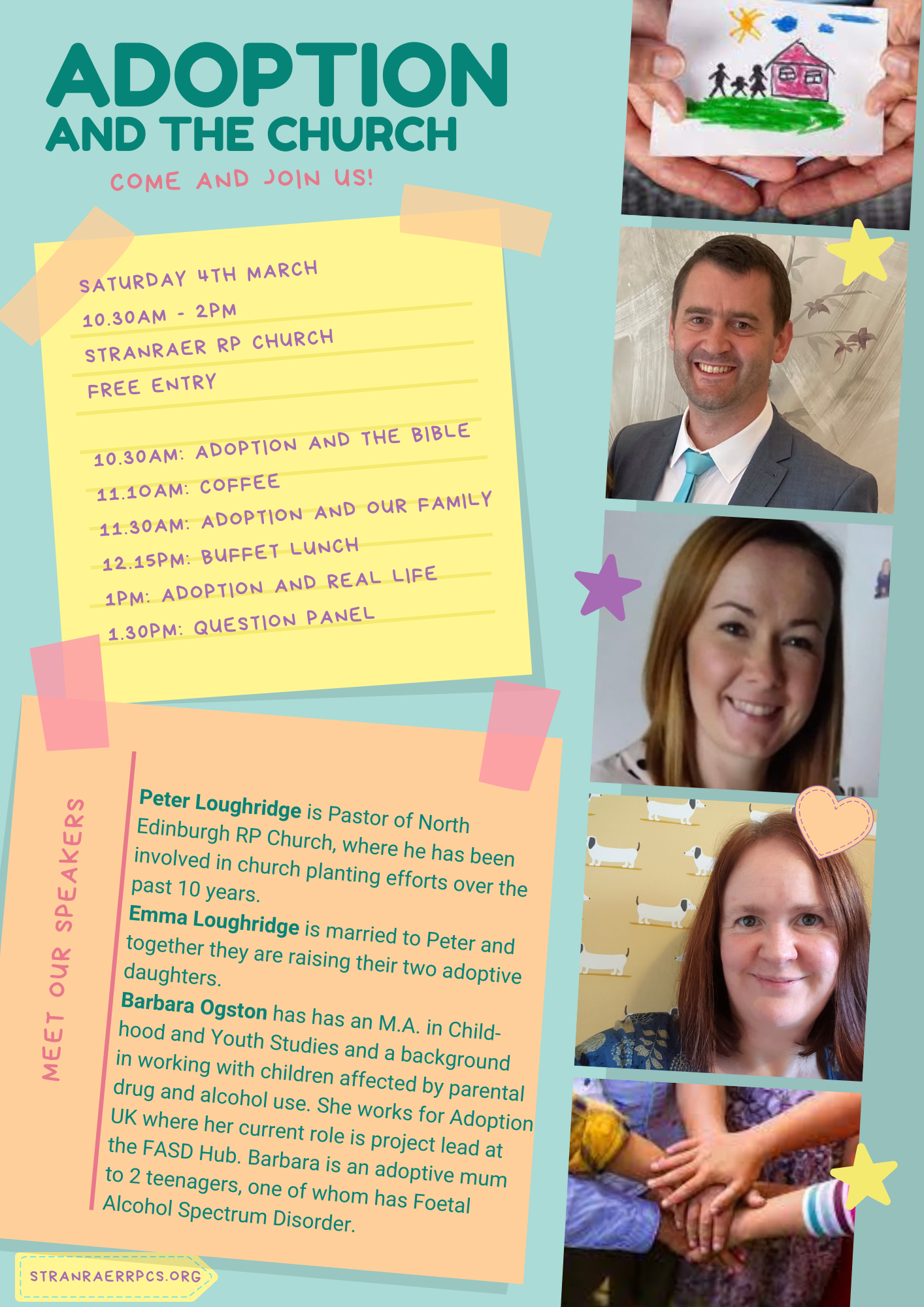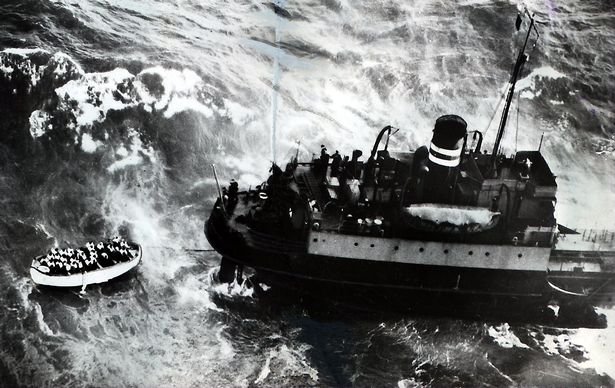We are planning to host a conference on Saturday 4th March on the subject of ‘Adoption and the Church’. It is open to everyone and all details are below:
Covenanters' attack on Stranraer castle
We recently did some open air outreach outside Stranraer Castle - also known as the Castle of St John. In the late 1600s, the Castle served as a prison for Covenanters as well as a base for Covenanting persecutor John Graham of Claverhouse - ‘Bloody Claverhouse’.
Around the summer of 1685, some Covenanters attacked the castle in order to rescue prisoners.
The historian Robert Wodrow records that:
On 15 October, 1685, the privy council appointed that ‘Hugh M’Kinasters, who has made discoveries of several persons rebels in Galloway, and who were accessory to the attack of the castle of Stranraer, whereof some are taken, to be further examined upon oath by the earl of Balcarras and [John Graham of] Claverhouse.’ (Wodrow, History, IV, 223.)
Dumfries & Galloway Council have an information leaflet about the Castle that you can view here. You can watch some recent drone footage of the Castle below:
Stephen joins the Gentle Reformation team
After having contributed a couple of guest articles in recent years, our minister Stephen was recently invited to become a regular contributor to the blog Gentle Reformation.
As the ‘About’ page states:
‘Gentle Reformation is a cooperative effort by friends in the R&P faith (Reformed and Presbyterian) to speak the Gospel of the Lord Jesus Christ in its many applications through the media of the internet. Our blog is intentionally styled:
to be persuasive rather than polemical (seeking to avoid the condescending pride that is, sadly, too often seen in R&P circles among those who, of all people, should be able knowledgeably to say “by the grace of God I am what I am”);
to speak in a tone that is pastoral rather than pejorative (though Biblical faithfulness demands that we cry “Wolf!” on occasion (see Matthew 7:15; Acts 20:29-31), we will be sure to do it only when warranted and not so often that we start sounding like that proverbial boy);
and to consider the people in the pews rather than professors and pastors as our primary audience (though many of us, being such ourselves, love pastors and professors and invite them to read along!).’
Since joining the team, Stephen has contributed 3 articles:
A Westminster Divine and an Alexandrian Codex (which was featured on the Evangelical Textual Criticism blog)
Killed by what they thought would save them (about the Princess Victoria - linked to by Tim Challies here)
My friend @barryjyork, President of @RPTSeminary has a site called Gentle Reformation (https://t.co/D037CeRXhs) that you should read. There is a good article up recently called "What majoring on the minors will do to you." Well worth your consideration. https://t.co/b7jijIayIy
— Ligon Duncan (@LigonDuncan) January 21, 2023
You can find all his past and future articles here. The initial plan is to contribute at least one article every two months, but more often as time allows.
Firm Foundations 2023
Last weekend, we held our second Firm Foundations weekend (the first one having been held in 2017).
10 young people from Northern Ireland came over for it, and we were joined by a couple of others from our own congregation, as well as another family from the region.
Our speaker was Rev. Kyle Borg from Winchester RP Church in Kansas. His topic was ‘How Christ the King rules in his church and leads in worship’.
Campbell, Shane, Hamish, Trinity, Heidi, Cameron, Chris and David arrived in time for dinner on the Friday evening.
Eleanor and Charis joined us late Friday night, in time for the first of Kyle’s four talks on Saturday morning.
On the Saturday afternoon we made use of the extra folk who were with us to do some open air psalm singing in the town centre, tying it in with the 70th anniversary of the Princess Victoria, which sank after leaving Stranraer on the last Saturday morning in January in 1953.
After the third talk, we had some Chinese food for dinner in the church hall. This was followed by the fourth and final talk, and then an extended question and answer time.
On the Lord’s Day our visitors joined us for worship, followed by a church lunch. After the evening service, there was another extended Q&A time (on all sorts of subjects) at the Frasers’ home.
On the Monday morning, we introduced the team to the classic Scottish ‘roll and sausage’ for breakfast before we said our goodbyes.
Overall it was a great weekend and we pray it will be a blessing in the lives of those who attended.
We hope to have video from the talks available at some point on our YouTube page.
The Princess Victoria: 70 years on
1953 saw the coronation of Queen Elizabeth II, the first documented ascent of Mount Everest (by Edmund Hillary) and the discovery of the DNA double helix. More significant than any of those for our own part of the world however was the loss of the Princess Victoria. Seventy years on, the horror of the deadliest UK maritime disaster since WWII has not lessened – nor have the stories of bravery been forgotten. A painting of the disaster by Norman Whitla, a minister I had the privilege of knowing, provides a vivid portrayal of the disaster. The painting shows lifeboat number four, containing women and children, about to be dashed against the side of the ship. As a result, only men survived the disaster. 135 perished, and only 44 survived. Those who lost their lives included the Deputy Prime Minister of Northern Ireland, the MP for North Down – and 23 people from Stranraer. Communities on both sides of the Irish sea were rocked by the events of that day – and have not forgotten them. A BBC programme made to mark the fortieth anniversary was entitled ‘Things don’t happen to boats like this’. And yet, tragically, they did.
So how do we reflect on this disaster seventy years on?
Well surely we are right to remember and highlight the bravery of many on that day. As the 30,000-page report concluded, ‘If the Princess Victoria had been as staunch as those who manned her, then all would have been well and the disaster averted’. The bravery of the captains and crew of ships who responded to the Victoria’s SOS message – including those who dived into the water to help survivors – was also acknowledged by the awarding of medals.
No doubt many from that day down to ours have asked the question ‘Where was God on 31st January 1953’? Did Jesus not calm a storm when he was on earth? Leaving experienced fishermen – who had been terrified by the storm – even more scared to see it instantly cease when he spoke. Could he not have done it again?
It all brings to mind another January maritime disaster – the sinking of the HMY Iolaire at the entrance to Stornoway harbour on 1 January 1919. The Iolaire (Gaelic for Eagle) was bringing sailors who had fought in WWI home to the Isle of Lewis when she hit rocks and sank. At least 201 of the 283 on board perished – of whom 181 were islanders. Almost an entire generation of young men was lost.
The people of Lewis erected a memorial to the disaster in 1958. On it are the words of Psalm 77:19 in Gaelic – ‘Your way was through the sea, your path through the great waters; yet your footprints were unseen’. It was an acknowledgement that even in such a disaster, God was still sovereign. That even though his ways are often unseen to us, that doesn’t mean he is absent.
And surely we can say the same about the 31st of January 1953. The very fact that seventy years later we still remember it shows how valuable we consider human life to be. If, as we’re often told, human life is no different from animal life, why bother remembering? If life is really about the survival of the fittest, why do we believe that those who risked – or even gave – their lives to save others, did the morally right thing?
What is the greatest expression of love? It’s a question that evolution cannot answer.
But the Bible’s answer is: ‘Greater love has no one than this, that someone lay down his life for his friends’.
Jesus Christ – the one who uttered those words – demonstrated exactly what that sort of love looked like by going to the cross. As Jesus hung on the cross, it looked like God was absent. Jesus himself cried out ‘My God, my God, why have you forsaken me?’
And yet while it looked for all the world like God was absent – as it did 70 years ago too – he was anything but. He was making a way for us to be reconciled to him.
In a sense we could say that humanity at its best was seen on 31st January 1953. In the bravery displayed and the selfless sacrifice shown. Humanity at its best reflects the image of our maker. And yet it still falls short of his glory.
But on the cross, the Son of God in his perfect, sinless humanity, gave his life that we might believe in him and live with him forever.
Published in the Stranraer & Wigtownshire Free Press, 26 January 2023














